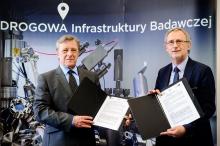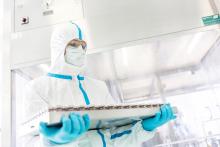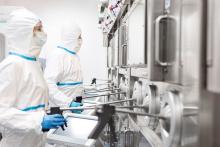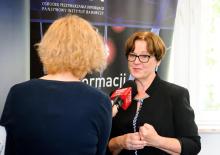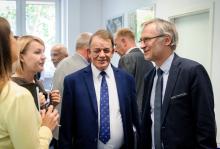Modern centre for design and synthesis of new radiopharmaceuticals is going to start operations in Świerk in three years. Scientists working in the centre will have at their disposal a new cyclotron, the Maria research reactor, a group of research labs, and the CIŚ supercomputer. To this end European Union will co-finance the CERAD project.
The CERAD project was launched to develop in Poland the technology of molecularly targeted drugs. The centre for drug design and synthesis will make possible to conduct comprehensive research on new drugs and related diagnostic/therapeutic procedures. NCBJ representing consortium of six research/academic institutions has reached an agreement on co-financing the CERAD project from EU funds allocated to the Smart Growth Operational Programme 2014-2020 (SGOP). The agreement was signed in Information Processing Centre – National Research Institute (OPI PIB) in Warsaw, an institution assigned the task to implement in Poland the SGOP 4th Priority Axis (“Increasing the research potential”, Action 4.2 „Development of modern research infrastructure in the science sector”).
„A brand new centre to be developed in Świerk within framework of the CERAD project will be conducting research on radiopharmaceuticals and will commercially offer its resources to all interested external entities. The centre equipped with a group of research labs and an unique cyclotron is going to start operations in three years” – said Dr. Krzysztof Kurek, NCBJ Director General. „It is expected that the existing resources of our Institute (including the Maria research reactor, the Polatom Radiopharmaceutical Centre, and the CIŚ supercomputer) in conjunction with the in-kind contribution and know-how of other members of the CERAD consortium will help the new centre to attain status of a truly European-class unique research infrastructure. Research carried out in the centre by domestic and international teams of researchers should help to develop some new methods to diagnose/treat serious diseases, for which currently used methods are ineffective”.
Total costs of the project have been estimated for about 120 million PLN, of which more than 75 million PLN will be funded by European Union.
„This is the second agreement for allocating funds from the SGOP programme signed by OPI PIB this year. Total value of all projects to be accomplished within the Action 4.2 framework exceeds 910 million PLN, including more than 560 million PLN co-financed by EU. All those projects are important both scientifically and economically. The projects reflect good relations between business community and scientific community. We hope that scientists working in the new NCBJ centre will manage to devise numerous practical solutions, while investors will be able to profitably use the centre infrastructure – said Dr. Olaf Gajl, OPI PIB Director.
A cyclotron capable to accelerate protons (to the energy of 30 MeV), deuterons (to 15 MeV) and alpha particles (to 30 MeV) will be the heart of the CERAD centre. Such energies are sufficient to produce radioactive isotopes needed in nuclear medicine; such isotopes are produced that way only in very few institutions in the world. Besides, some isotopes will be produced by means of irradiating suitable targets with beams of neutrons produced by the Maria reactor operated in Świerk. Some new labs built within the CERAD project framework and some existing labs currently run by the NCBJ Polatom Radioisotope Centre will be combined into a comprehensive infrastructure necessary to synthesize and study new radiopharmaceuticals based on radioisotopes produced by the cyclotron/Maria reactor. The new centre building will house some labs equipped with hot chambers necessary to safely manipulate radioactive materials, some analytical labs, and some biology labs. Scientists will be able to run on site pre-clinical tests of the drugs under development. Participation of some medical universities in the consortium will enable smooth transition to the clinical test phase with the most prospective solutions as soon as the required permits are granted by suitable bioethics commissions. The CIŚ supercomputer operated in Świerk and competences of the CIŚ centre staff will assist the researchers in making comprehensive simulations of the new drugs.
„CERAD centre’s mission is to develop original, effective, and safe drugs” – explains Professor Renata Mikołajczak, Polatom Radiopharmaceutical Centre Director Proxy for scientific matters and collaboration with external partners home and abroad, also Head of the CERAD project. „A wide range of radio-isotopes available from cyclotron/reactor combination will enable us to design numerous isotope markers capable to diagnose various diseases sooner and more accurately, hence to more promptly implement a proper treatment of the disease. We want to combine isotope techniques with other diagnostic methods, such as those based on disease molecular markers and magnetic resonance imaging. A wide range of available radio-isotopes will enable us also to optimally match radiation energy and biological half-life to the nature/advancement of the disease and individual situation of each given patient. We intend to develop both final drugs and drug precursors necessary in production of radiopharmaceuticals”.
Production of radiopharmaceuticals is a multi-stage process. First, cyclotron-accelerated protons/deuterons/alpha particles or reactor-emitted neutrons hit a target of some specially selected chemical composition. Nuclear reactions between bombarding particles and nuclei of target elements produce some radio-isotopes of those elements. List of nuclides interesting from the point of view of medical applications is a few dozen items long, from the lightest carbon C-11 to the heaviest actinium Ac-225. Next, radio-isotopes produced within the targets must be extracted and accurately purified. To this end, both physical and chemical methods are applied. Next, atoms of purified radio-isotopes are attached to some appropriate chemical structures (molecules) of a good affinity to target tissues within patient body, e.g. to cancer cells. The structures play the role of carriers bringing the attached radio-nuclides to their desired destinations. Most often some peptides preferentially accumulated in malignant cells are selected as the carriers.
If some radionuclide emitting long-range beta or gamma radiation is selected, the radiopharmaceutical may help to diagnose the disease. Usually conventional PET or SPECT medical imaging scanners are used to produce maps of points from which decaying radionuclides emit the radiation i.e. maps showing distribution of malignant cells. However, if some other radionuclide emitting short-range high-energy radiation is used, the radiopharmaceutical may help to treat the disease as such radiation kills the cell hosting the decaying radioisotope.
Major challenge that the researchers developing new radio-pharmaceuticals must face is to find optimal combinations of the radio-nuclides and their carriers. If carrier molecules applied in a diagnostic procedure are not very preferentially absorbed by pathologically changed cells only, the procedure results will be poor. If carrier molecules applied in a therapeutic procedure are not very preferentially absorbed by pathologically changed cells only, radiotherapy undesired side effects may be a major problem.
Research infrastructure to be developed with the CERAD project framework will be open to other research projects, for example those accomplished within the European Strategy Forum on Research Infrastructures network, the Radio-Pharmacy & Nuclear Medicine network, COST, Short Term Scientific Missions, International Atomic Energy Agency (IAEA) scholarships etc. The to-be-developed CERAD centre has already attracted interest of numerous institutions abroad. Students of academic- or post-graduate level educational programmes will also be able to access the infrastructure; in particular radio-pharmacy students of the Centre of Postgraduate Medical Education and IAEA trainees will be trained here. Each submitted proposal will be evaluated by CERAD Consortium Council from the scientific quality, total costs, and needed resources points of view. The Centre will also accept commercial orders for conducting research on and/or for producing specific radio-pharmaceuticals.
Members of the CERAD consortium: NCBJ, Warsaw University, Institute of Nuclear Chemistry and Technology in Warsaw, Warsaw Medical University, Collegium Medicum of the Jagiellonian University in Cracow, Medical University in Białystok. Works of the consortium are coordinated by NCBJ.

